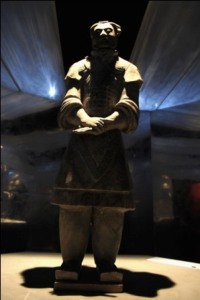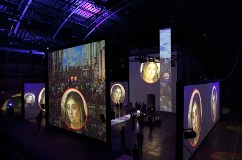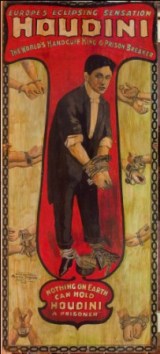Category: "Exhibits"
Review: Terracotta Warriors: Defenders of China’s First Emperors
Spy: The Secret World of Espionage
Jun 7th

Thanks to Discovery Times Square, there’s a lot more to do in the theater district than just see a Broadway show. This massive space located in the former digs of the New York Times has played host to a series of fascinating exhibitions, with this summer’s diverse offerings being Terracotta Warriors: Defenders of China’s First Emperor and the rather more modern Spy: The Secret World of Espionage.
Unless you’re fortunate enough to be visiting China, Terracotta Warriors is the closest you’ll get to these magnificent figures that are more than 2,000 years old. Or, at least a tiny portion of them: The show includes only ten (the maximum allowed to leave China) of the some 8,000 life-size terracotta warriors, each weighing approximately 600 pounds, which were built for the tomb of the ancient Chinese emperor Qin Shiguangdi to protect him in the afterlife.
Buried with him in the second century BCE, they were only discovered by accident in 1974 by some farmers who were digging a well outside the city of Xian. A massive museum eventually sprung up to showcase them, although since then samples have toured museums throughout the world.
And now they’ve shown up in Times Square, in a beautifully laid-out exhibition that well showcases their ancient glory. The bright colors that once adorned the hyper-realistic figures have long since faded away. But as dramatically lit and presented here, they exert a compelling fascination nonetheless.
Representing various military ranks from generals to foot soldiers, this clay figures feature elaborate uniforms, unique facial expressions and, in one striking case, a life-size horse.
There’s much more to see as well. Brief film selections provide historical background information, which you’ll no doubt find illuminating unless you happen to be up on ancient Chinese history. The exhibition also includes over 200 artifacts from the period, many of which were originally buried with the warriors in the emperor’s tomb. They include a spectacular suit of armor, jewelry, musical instruments, a bronze ritual vessel, gold ornaments, and most notably, gates from an ancient Han burial chamber that is being displayed for the first time since its discovery.

The most appropriate attire for attending Spy: The Secret World of Espionage is a trench coat and fedora, the better to get you into the proper frame of mind for this fascinating show of objects relating to the world of espionage. Culled from the collections of the CIA, FBI, National Reconnaissance Office and especially the voluminous private collection of historian H. Keith Melton (author of such books as The Ultimate Spy and the forthcoming Spy’s Guide to New York City), the exhibition provides endless insight into the world of spies, largely through the tools of the trade.
Thus you’ll see such artifacts, many of them previously hidden, as a collapsible motorbike employed by Allied parachute forces in World War II; a dead rat with a hollow cavity used for dead drops in Moscow during the Cold War (hot pepper sauce was sprinkled on them to prevent them from being carried away by rapacious cats); a lifelike robot catfish, one of only two in existence; an Enigma Machine used by German military forces to create supposedly unbreakable codes; a STASI infrared attaché case equipped for covert photography; and a KGB model of the bugged US Embassy building in Moscow.
History buffs, albeit those of a ghoulish bent, will be thrilled to see the actual blood-stained axe used in the assassination of Leon Trotsky as well as the broken eyeglasses of his killer.
There are special sections devoted to such topics as homing pigeons that were used as couriers in World War II; U-2 spy planes, such as the one piloted by Gary Powers shot down by a Russian missile; and such recent infamous traitors as Aldrich Ames, John Walker and Robert Hanssen. There’s also special attention paid to Anna Chapman, the comely but amateurish Russian spy who achieved tabloid notoriety.
The show also includes cheesy interactive elements in which you can alter your own photograph and voice and dodge laser beams in Mission: Impossible style. And I’m not sure it needed to include a full-size recreation of the Oval Office. But these quibbles aside, Spy compellingly brings to light the gritty professional details of a milieu most of us know only from headlines and sensationalistic thrillers.
Discovery Times Square, 226 W. 44th St. 866-987-9862. www.discoverytsx.com. Terracotta Warriors through Aug. 26. Spy through Mar. 31.
Review: Leonardo’s Last Supper: A Vision by Peter Greenaway
Dec 14th
 Unless you’re planning a trip to Italy anytime soon, you might want to head over the Park Avenue Armory, where filmmaker Peter Greenaway (The Cook, the Thief, his Wife & Her Lover, The Draughtsman’s Contract) has installed his massive recreation/deconstruction of Leonardo da Vinci’s classic painting The Last Supper.
Unless you’re planning a trip to Italy anytime soon, you might want to head over the Park Avenue Armory, where filmmaker Peter Greenaway (The Cook, the Thief, his Wife & Her Lover, The Draughtsman’s Contract) has installed his massive recreation/deconstruction of Leonardo da Vinci’s classic painting The Last Supper.
Entitled Leonardo’s Last Supper: A Vision by Peter Greenaway, this high-tech multi-media installation is ultimately more impressive on a technical rather than aesthetic level. But it does provide the opportunity for visitors to feast on a perfect replication of da Vinci’s masterpiece, which is currently rapidly deteriorating in its home inside the Santa Maria delle Grazie monastery in Milan.
Greenaway has made a late career specialty out of elaborate digital explorations of classic artworks, most of them presented in the same venues housing the original works. This traveling installation actually combines two of his previous efforts, the other being a treatment of Paolo Veronese’s late-Renaissance work The Wedding at Cana.
Upon entering the armory’s cavernous drill hall, visitors are first regaled with a giant-screen video and music montage featuring scenic footage of various Italian locations and digitally enhanced shots of a ballet dancer leaping about.
From there, we enter the main area, which includes a three-dimensional re-creation of the Last Supper dining table, rendered entirely in white. On the opposite side is a life-sized duplication of the iconic painting, which anyone who’s seen the original knows has aged badly.
Greenaway compensates for this with digital enhancement that restores the once vibrant colors. For the next 20-30 minutes, different sections of the painting are highlighted in ways that call attention to details that might otherwise be missed. Projected images of small sections from the painting, rendered in close-up, are seen on large screens surrounding the space. It’s all suitably accompanied by religious music.
The overall effect is undeniably arresting in a high-tech way, if ultimately rather repetitive and gimmicky. The piece might have been better served by a little less visual trickery and the addition of some narration that might have provided some historical and artistic context.
And the addition of the similar treatment of Cana seems less essential to the overall experience than an attempt to justify the rather high $15 admission charge.
Still, this represents an intriguing idea, one that its creator apparently aims to use in exploring other masterworks in the future. Despite this piece’s limitations, the overall goal, which is to make us see classic works of art in new and unexpected ways, is one to be encouraged.
Park Avenue Armory, 643 Park Ave. 212-616-3939. www.armoryonpark.org. Through Jan. 6.
Review: Houdini: Art and Magic at the Jewish Museum
Nov 11th
Jewish Museum, NYC
Through Mar. 27.
 One of the most compelling museum exhibitions in town is the one at the Jewish Museum devoted to the life and career of Ehrich Weiss.
One of the most compelling museum exhibitions in town is the one at the Jewish Museum devoted to the life and career of Ehrich Weiss.
You might ask, Erich who? Well, you’re probably more familiar with his stage name: Harry Houdini.
The famed magician was actually the son of Hungarian Jews who settled in Wisconsin in the late 1870s. Neither his father, who was a rabbi, nor his mother spoke English.
Despite his humble immigrant beginnings, Houdini, as he later dubbed himself (after his early idol, the French magician Robert-Houdin) became an international megastar, one of the first of the twentieth century. His celebrated escapes from restraints and obstacles of all kindd clearly had a metaphorical resonance for ordinary citizens themselves struggling under the extraordinarily difficult conditions of the era.
“Houdini: Art and Magic” explores his legacy through a mixture of memorabilia and artifacts, video clips and multi-media artworks inspired by the subject.
The latter are the least interesting aspects of the exhibition, with only a few pieces, such as Ikuo Nakamura’s milk can featuring a hologram of a pair of manacled hands emerging (echoing one of Houdini’s most famous escapes), having much impact. Particularly trivial is a lavish abstract installation, “The Ehrich Weiss Suite,” by artist/filmmaker Matthew Barney, whose “Cremaster 2” film featured Houdini, played by Norman Mailer, no less, as a character. It features, among other things, a glass coffin littered with the droppings of several live pigeons.
But Houdini aficionados will relish the rare opportunity to examine such classic items integral to his act as a milk can from which he made his escapes; the steamer trunk used in the classic “Metamorphosis” illusion; handcuffs, one of his straitjackets, and letters and journal entries.
Sadly, the most striking prop on display, the large box with the glass front used for his famous “Chinese Water Torture Cell” escape, is a recreation. The original was ravaged in a 1995 fire that destroyed the Houdini Magical Hall of Fame in Niagara Falls, Canada.
Jewish Museum, 1109 Fifth Ave. 212-423-3200. www.thejewishmsuem.org.